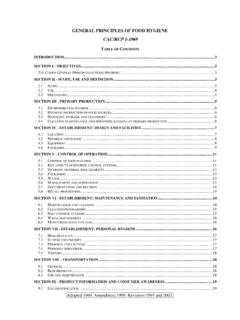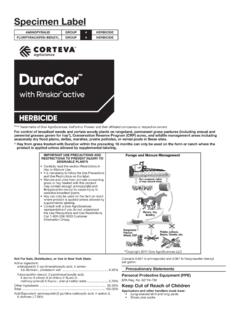Transcription of SLAUGHTER OF ANIMALS - OIE
1 2021 OIE - Terrestrial animal Health Code - 19/07/20211C H A P T E R 7 . 5 .S L A U G H T E R O F A N I M A L SArticle recommendations address the need to ensure the welfare of food ANIMALS during pre- SLAUGHTER andslaughter processes, until they are recommendations apply to the SLAUGHTER in slaughterhouses/abattoirs of the following domestic ANIMALS :cattle, buffalo, bison, sheep, goats, camelids, deer, horses, pigs, ratites, rabbits and poultry. Other ANIMALS ,wherever they have been reared, and all ANIMALS slaughtered outside slaughterhouses/abattoirs should bemanaged to ensure that their transport, lairage, restraint and SLAUGHTER is carried out without causing undue stressto the ANIMALS ; the principles underpinning these recommendations apply also to these engaged in the unloading, moving, lairage, care, restraint, stunning, SLAUGHTER and bleeding of animalsplay an important role in the welfare of those ANIMALS .
2 For this reason, there should be a sufficient number ofpersonnel, who should be patient, considerate, competent and familiar with the recommendations outlined in thischapter and their application within the national may be gained through formal training and/or practical experience. This competence should bedemonstrated through a current certificate from the Competent Authority or from an independent body accreditedby the Competent management of the slaughterhouses/abattoirs and the Veterinary Services should ensure thatslaughterhouse/abattoir staff are competent and carry out their tasks in accordance with the principles of behaviourAnimal handlers should be experienced and competent in handling and moving farm livestock, and understand thebehaviour patterns of ANIMALS and the underlying principles necessary to carry out their behaviour of individual ANIMALS or groups of ANIMALS will vary, depending on their breed, sex, temperamentand age and the way in which they have been reared and handled.
3 Despite these differences, the followingbehaviour patterns which are always present to some degree in domestic ANIMALS , should be taken intoconsideration in handling and moving the domestic livestock are kept in groups and follow a leader by which are likely to harm each other in a group situation should not be mixed at desire of some ANIMALS to control their personal space should be taken into account in designing ANIMALS will try to escape if any person approaches closer than a certain distance. This critical distance,which defines the flight zone, varies among species and individuals of the same species, and depends uponprevious contact with humans. ANIMALS reared in close proximity to humans tame have a smaller flight zone,whereas those kept in free range or extensive systems may have flight zones which may vary from one metre to22021 OIE - Terrestrial animal Health Code - 19/07/2021 Chapter SLAUGHTER of animalsmany metres.
4 animal handlers should avoid sudden penetration of the flight zone which may cause a panic reactionwhich could lead to aggression or attempted handlers should use the point of balance at the animal s shoulder to move ANIMALS , adopting a positionbehind the point of balance to move an animal forward and in front of the point of balance to move it ANIMALS have wide-angle vision but only have limited forward binocular vision and poor perception ofdepth. This means that they can detect objects and movements beside and behind them, but can only judgedistances directly most domestic ANIMALS have a highly sensitive sense of smell, they react in different ways to the smellsof slaughterhouses/abattoirs. Smells which cause fear or other negative responses should be taken intoconsideration when managing ANIMALS can hear over a greater range of frequencies than humans and are more sensitive to higherfrequencies.
5 They tend to be alarmed by constant loud noise and by sudden noises, which may cause them topanic. Sensitivity to such noises should also be taken into account when handling and their removalDistractions that may cause approaching ANIMALS to stop, baulk or turn back should be designed out from newfacilities or removed from existing ones. Below are examples of common distractions and methods for eliminatingthem:a) reflections on shiny metal or wet floors move a lamp or change lighting;b) dark entrances to chutes, races, stun boxes or conveyor restrainers illuminate with indirect lighting whichdoes not shine directly into the eyes of approaching ANIMALS or create areas of sharp contrast;c) ANIMALS seeing moving people or equipment up ahead install solid sides on chutes and races or installshields;d) dead ends avoid if possible by curving the passage, or make an illusory passage;e) chains or other loose objects hanging in chutes or on fences remove them;f) uneven floors or a sudden drop in floor levels at the entrance to conveyor restrainers avoid uneven floorsurfaces or install a solid false floor under the restrainer to provide an illusion of a solid and continuous walkingsurface.
6 G) sounds of air hissing from pneumatic equipment install silencers or use hydraulic equipment or vent highpressure to the external environment using flexible hosing;h) clanging and banging of metal objects install rubber stops on gates and other devices to reduce metal tometal contact;i) air currents from fans or air curtains blowing into the face of ANIMALS redirect or reposition example of a flight zone (cattle)Chapter SLAUGHTER of animals2021 OIE - Terrestrial animal Health Code - 19/07/20213 Handler movement pattern to move cattle forwardArticle and handling considerationsEach slaughterhouse/abattoir should have a dedicated plan for animal welfare. The purpose of such a plan shouldbe to maintain good level of animal welfare at all stages of the handling of ANIMALS until they are killed. The planshould contain standard operating procedures for each step of animal handling as to ensure that animal welfare isproperly implemented based on relevant indicators.
7 It also should include specific corrective actions in case ofspecific risks, like power failures or other circumstances that could negatively affect the welfare of should be transported to SLAUGHTER in a way that minimises adverse animal health and welfare outcomes,and the transport should be conducted in accordance with the OIE recommendations for the transportation ofanimals ( and ).The following principles should apply to unloading ANIMALS , moving them into lairage pens, out of the lairage pensand up to the SLAUGHTER point:a) The conditions of the ANIMALS should be assessed upon their arrival for any animal welfare and ) Injured or sick ANIMALS , requiring immediate SLAUGHTER , should be killed humanely and without delay, inaccordance with the recommendations of the ) ANIMALS should not be forced to move at a speed greater than their normal walking pace, in order to minimiseinjury through falling or slipping.
8 Performance standards should be established where numerical scoring ofthe prevalence of ANIMALS slipping or falling is used to evaluate whether animal moving practices and/orfacilities should be improved. In properly designed and constructed facilities with competent animal handlers ,it should be possible to move 99% of ANIMALS without their ) ANIMALS for SLAUGHTER should not be forced to walk over the top of other ) ANIMALS should be handled in such a way as to avoid harm, distress or injury. Under no circumstances shouldanimal handlers resort to violent acts to move ANIMALS , such as crushing or breaking tails of ANIMALS , graspingtheir eyes or pulling them by the ears. animal handlers should never apply an injurious object or irritantsubstance to ANIMALS and especially not to sensitive areas such as eyes, mouth, ears, anogenital region orbelly. The throwing or dropping of ANIMALS , or their lifting or dragging by body parts such as their tail, head,horns, ears, limbs, wool, hair or feathers, should not be permitted.
9 The manual lifting of small ANIMALS ) When using goads and other aids, the following principles should apply:i) ANIMALS that have little or no room to move should not be subjected to physical force or goads and otheraids which compel movement. Electric goads and prods should only be used in extreme cases and noton a routine basis to move ANIMALS . The use and the power output should be restricted to that necessaryto assist movement of an animal and only when an animal has a clear path ahead to move. Goads and42021 OIE - Terrestrial animal Health Code - 19/07/2021 Chapter SLAUGHTER of animalsother aids should not be used repeatedly if the animal fails to respond or move. In such cases it shouldbe investigated whether some physical or other impediment is preventing the animal from ) The use of such devices should be limited to battery-powered goads on the hindquarters of pigs andlarge ruminants, and never on sensitive areas such as the eyes, mouth, ears, anogenital region or instruments should not be used on horses, sheep and goats of any age, or on calves or ) Useful and permitted goads include panels, flags, plastic paddles, flappers (a length of cane with a shortstrap of leather or canvas attached), plastic bags and metallic rattles.
10 They should be used in a mannersufficient to encourage and direct movement of the ANIMALS without causing undue ) Painful procedures (including whipping, kicking, tail twisting, use of nose twitches, pressure on eyes,ears or external genitalia), or the use of goads or other aids which cause pain and suffering (includinglarge sticks, sticks with sharp ends, lengths of metal piping, fencing wire or heavy leather belts), shouldnot be used to move ) Excessive shouting at ANIMALS or making loud noises ( through the cracking of whips) to encouragethem to move should not occur, as such actions may make the ANIMALS agitated, leading to crowding ) ANIMALS should be grasped or lifted in a manner which avoids pain or suffering and physical damage( bruising, fractures, dislocations). In the case of quadrupeds, manual lifting by a person should onlybe used in young ANIMALS or small species, and in a manner appropriate to the species; grasping orlifting such ANIMALS only by their wool, hair, feathers, feet, neck, ears, tails, head, horns, limbs causingpain or suffering should not be permitted, except in an emergency where animal welfare or human safetymay otherwise be ) Conscious ANIMALS should not be thrown, dragged or ) Performance standards should be established to evaluate the use of such instruments.












